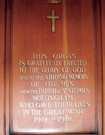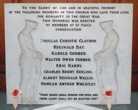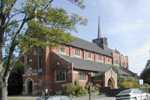For this church:    |
|
| THIS ORGAN IS GRATEFULLY ERECTED TO THE GLORY OF GOD AND TO THE ABIDING MEMORY OF THE MEN FROM THE PARISH OF ST. STEPHEN NOTTINGHAM, WHO GAVE THEIR LIVES IN THE GREAT WAR 1914 - 1918 |
160 names were inscribed.
Below the inscription is a cabinet containing, originally, two Books of Remembrance, under a glass cover, recording the names of St Stephen’s parishioners who served in World War I. The book, cream bound, hard back, in leather with gold embroidery, is of 34 pages and contains 642 names (surnames, initials, regiment). It was designed and illuminated by Carrie V Neal. Those who died, and whose names are therefore recorded on the organ casing, are recorded in red ink. The cabinet also includes ‘Book of Remembrance 1939-1945', leather bound with gold embroidered edging. It contains 34 pages, with 404 entries. All entries are in black with the service title in royal blue. Royal blue crosses to the left of some entries presumably indicate that the individual died in action.
There is also a Roll of Honour on the inside wall near the south porch, originally recording those on active service in the Great War, but subsequently amended to indicate those who died or were killed in action. It includes 341 names in a semblance of alphabetical order and 112 names written in after ‘W’ in no particular order. The names are a mix of the Remembrance Book, and other additions. The wording on the inscription suggests that ht was regarded as a working document: ‘Please remember in prayer the following who are on active service’.
St Paul’s Parish Memorial
A marble plaque from St Paul’s church rests at the foot of the screen. Names of church members who died in the Great War are inscribed on it.
 The
dedication panel The
dedication panelon the side of the organ |
 The
Book of Remembrance The
Book of Remembrance |
 The St Paul’s War Memorial, The St Paul’s War Memorial,now in St Stephen’s |






